Aptamer Affinity-Bead Mediated Capture and Displacement of Gram-Negative Bacteria Using Acoustophoresis
Abstract
1. Introduction
2. Materials and Methods
2.1. Microfluidic Acoustophoresis Chip Design
2.2. Acoustophoresis Setup
2.3. Bacterial Strains and Culture
2.4. Microbeads and Immobilization of Aptamer onto Microbeads
2.5. Acoustophoresis
3. Results and Discussion
4. Conclusions
Author Contributions
Funding
Conflicts of Interest
References
- Josenhans, C.; Suerbaum, S. The role of motility as a virulence factor in bacteria. Int. J. Med. Microbiol. 2002, 291, 605–614. [Google Scholar] [CrossRef] [PubMed]
- Whitehead, N.; Barnard, M.; Slater, H.; Simpson, N.; Salmond, G. Quorum-sensing in Gram-negative bacteria. FEMS Microbiol. Rev. 2001, 25, 365–404. [Google Scholar] [CrossRef] [PubMed]
- Delcour, A.H. Outer Membrane permeability and antibiotic resistance. Biochim. Biophys. Acta Proteins Proteom. 2009, 1794, 808–816. [Google Scholar] [CrossRef] [PubMed]
- Kingwell, K. New antibiotic hits Gram-negative bacteria. Nature 2018, 17, 785. [Google Scholar] [CrossRef] [PubMed]
- Rosenfeld, Y.; Shai, Y. Lipopolysaccharide (Endotoxin)-host defense antibacterial peptides interactions: Role in bacterial resistance and prevention of Sepsis. Biochim. Biophys. Acta Biomembr. 2006, 1758, 1513–1522. [Google Scholar] [CrossRef] [PubMed]
- Peterson, E.; Kaur, P. Antibiotic resistance mechanisms in bacteria: relationships between resitance determinants of antibiotic producers, environmental bacteria and clinical pathogens. Front. Microbiol. 2018, 9, 2928. [Google Scholar] [CrossRef] [PubMed]
- Hormozi, S.F.; Vasei, N.; Aminianfar, M.; Darvishi, M.; Saeedi, A.A. Antibiotic resistance in patients suffering from nosocomial infections in Besat Hospital. Eur. J. Transl. Myol. 2018, 28, 7594. [Google Scholar] [CrossRef] [PubMed]
- Hirvonen, J.; von Lode, P.; Nevalainen, M.; Rantakokko-Jalava, K.; Kaukoranta, S. One-step sample preparation of positive blood cultures for the direct detection of methicillin-sensitive and-resistant Staphylococcus aureus and methicillin-resistant coagulase-negative staphylococci within one hour using the automated GenomEra CDXTM PCR system. Eur. J. Clin. Microbiol. Infect. Dis. 2012, 31, 2835–2842. [Google Scholar] [PubMed]
- Swaminathan, B.; Feng, P. Rapid detection of food-borne pathogenic bacteria. Annu. Rev. Microbiol. 1994, 48, 401–426. [Google Scholar] [CrossRef] [PubMed]
- Wu, M.; Ozcelik, A.; Rufo, J.; Wang, Z.; Fang, R.; Huang, T. Acoustofluidic separation of cells and particles. Microsyst. Nanoeng. 2019, 5, 32. [Google Scholar] [CrossRef] [PubMed]
- Ohlsson, P.; Evander, M.; Petersson, K.; Mellhammar, L.; Lehmusvuori, A.; Karhunen, U.; Soikkeli, M.; Seppa, T.; Tuunainen, E.; Spangar, A.; et al. Integrated acoustic separation, enrichment, and microchip polymerase chain reaction detection of bacteria from blood for rapid sepsis diagnostics. Anal. Chem. 2016, 88, 9403–9411. [Google Scholar] [CrossRef] [PubMed]
- Urbansky, A.; Lenshof, A.; Dykes, J.; Laurell, T.; Scheding, S. Affinity-bead-mediated enrichment of CD8+ lymphocytes from pheripheral blood progenitor cell products using acoustophoresis. Micromachines 2016, 7, 101. [Google Scholar] [CrossRef] [PubMed]
- Shields, C.W.; Reyes, C.D.; Lopez, G.P. Microfluidic cell sorting: a review of the advances in the separation of cells from debuling to rare cell isolation. Lab Chip 2015, 15, 1230. [Google Scholar] [CrossRef] [PubMed]
- Sarkar, A.; Hou, H.W.; Mahan, A.E.; Han, J.Y.; Alter, G. Multiplexed affinity-based separation of proteins and cells using inertial microfluidics. Sci. Rep. 2016, 6, 23589. [Google Scholar] [CrossRef] [PubMed]
- Zhang, Y.; Lai, B.S.; Juhas, M. Recent advances in aptamer discovery and application. Molecues 2019, 24, 941. [Google Scholar] [CrossRef] [PubMed]
- Nimjee, S.M.; White, R.; Becker, R.; Sullenger, B.A. Aptamer as therapeutics. Annu. Rev. Pharmacol. Toxicol. 2017, 57, 61–79. [Google Scholar] [CrossRef] [PubMed]
- Klussmann, S. The Aptamer Handbook: Functional Oligonucleotides and Their Applications; Wiley-VCH: Weinheim, Germany, 2006. [Google Scholar]
- Ellington, A.; Szostak, J.W. In vitro selection of RNA molecules that bind specific ligands. Nature 1990, 346, 818–822. [Google Scholar] [CrossRef] [PubMed]
- Tuerk, C.; Gold, L. Systematic evolution of ligands by exponential enrichment: RNA ligands to bacteriophage T4 DNA polymerase. Science 1990, 249, 505–510. [Google Scholar] [CrossRef] [PubMed]
- Hamula, C.L.A.; Zhang, H.; Guan, L.L.; Li, X.F.; Le, C. Selection of aptamers against live bacterial cells. Anal. Chem. 2008, 80, 7812–7819. [Google Scholar] [CrossRef] [PubMed]
- Tang, Z.; Parekh, P.; Turner, P.; Moyer, R.W.; Tan, W. Generating aptamers for recognition of virus-infected cells. Clin. Chem. 2009, 55, 813–822. [Google Scholar] [CrossRef] [PubMed]
- Shangguan, D.; Meng, L.; Cao, Z.; Xiao, Z.; Fang, X.; Li, Y.; Cardona, D.; Witek, R.; Liu, C.; Tan, W. Identification of liver cancer-specific aptamers using whole live cells. Anal. Chem. 2008, 80, 721–728. [Google Scholar] [CrossRef] [PubMed]
- Chen, M.; Yu, Y.; Jing, F.; Zhou, J.; Li, Y.; Liang, C.; Dang, L.; Lu, A.; Zhang, G. Development of Cell-SELEX technology and its application in cancer diagnosis and therapy. Int. J. Mol. Sci. 2016, 17, 2079. [Google Scholar] [CrossRef] [PubMed]
- Ding, X.; Lin, S.C.; Kiraly, B.; Yue, H.; Li, S.; Chiang, I.; Shi, J.; Benkovic, S.J.; Huang, T. On-chip manipulation of single microparticles, cells, and organisms using surface acoustic waves. Proc. Natl. Acad. Sci. USA 2012, 109, 11105–11109. [Google Scholar] [CrossRef] [PubMed]
- Karthick, S.; Pradeep, P.N.; Kanchana, P.; Sen, A.K. Acoustic impedance-based size independent isolation of circulating tumor cells from blood using acoustophoresis. Lab Chip 2018, 18, 2802–3813. [Google Scholar] [CrossRef] [PubMed]
- Lenshof, A.; Magnusson, C.; Laurell, T. Acoustofluidics 8: Applications of acoustophoresis in continuous flow microsystems. Lab Chip 2012, 12, 1210–1223. [Google Scholar] [CrossRef] [PubMed]
- Persson, J.; Augustsson, P.; Laurell, T.; Ohlin, M. Acoustic microfluidic chip technology to facilitate automation of phage display selection. FEBS J. 2008, 275, 5657–5666. [Google Scholar] [CrossRef] [PubMed]
- Park, J.W.; Lee, S.J.; Ren, S.; Lee, S.W.; Kim, S.; Laurell, T. Acousto-microfluidics for screening of ssDNA aptamer. Sci. Rep. 2016, 6, 27121. [Google Scholar] [CrossRef] [PubMed]
- Shields, C.W.; Johnson, L.M.; Gao, L.; Lopez, G.P. Elestomeric negative acoustic contrast particles for capture, acoustophoretic transport, and confinement of cells in microfluidic systems. Langmuir 2014, 30, 3923. [Google Scholar] [CrossRef] [PubMed]
- Shin, H.S.; Gedi, V.; Kim, J.K.; Lee, D.K. Detection of Gram-negative bacterial outer membrane vesicles using DNA aptamers. Sci. Rep. 2019, 9, 13167. [Google Scholar] [CrossRef] [PubMed]
- Friend, J.; Yeo, L.Y. Microscale acoustofluidics: Microfluidics driven via acoustic and ultrasonics. Rev. Mod. Phys. 2011, 83, 647. [Google Scholar] [CrossRef]
- Mach, A.J.; Di Carlo, D. Continuous scalable blood filtration device using inertia microfluidics. Biotechnol. Bioeng. 2010, 107, 302. [Google Scholar] [CrossRef] [PubMed]
- Wang, S.; Sarenac, D.; Chen, M.H.; Huang, S.H.; Giguel, F.F.; Kuritzkes, D.R.; Demirci, U. Simple filter microchip for rapid separation of plasma and viruses from whole blood. Int. J. Nanomed. 2012, 7, 5019. [Google Scholar]
- Ai, Y.; Sanders, C.K.; Marrone, B.L. Separation of Escherichia coli bacteria from peripheral blood mononuclear cells using standing surface acoustic waves. Anal. Chem. 2013, 85, 9126e9134. [Google Scholar] [CrossRef] [PubMed]
- Ohlsson, P.; Petersson, K.; Augustsson, P.; Laurell, T. Acoustic impedance matched buffers elable separation of bacteria from blood cells at high cell concentration. Sci. Rep. 2018, 8, 9156. [Google Scholar] [CrossRef] [PubMed]
- Park, S.; Zhang, Y.; Wang, T.H.; Yang, S. Continuous dielectrophoretic bacteria separation and concentration from physiological media of high conductivity. Lab Chip 2011, 11, 2893. [Google Scholar] [CrossRef] [PubMed]
- Kim, U.; Soh, H.T. Simultaneous sorting of multiple bacterial targets using integrated dielectrophoretic-Magnetic Activated Cell Sorter. Lab Chip 2009, 9, 2313. [Google Scholar] [CrossRef] [PubMed]
- Cai, G.; Wang, S.; Zheng, L.; Lin, J. A fluidic device for immunomagnetic separation of foodborne bacteria using self-assembled magnetic nanoparticle chains. Micromachines 2018, 9, 624. [Google Scholar] [CrossRef] [PubMed]
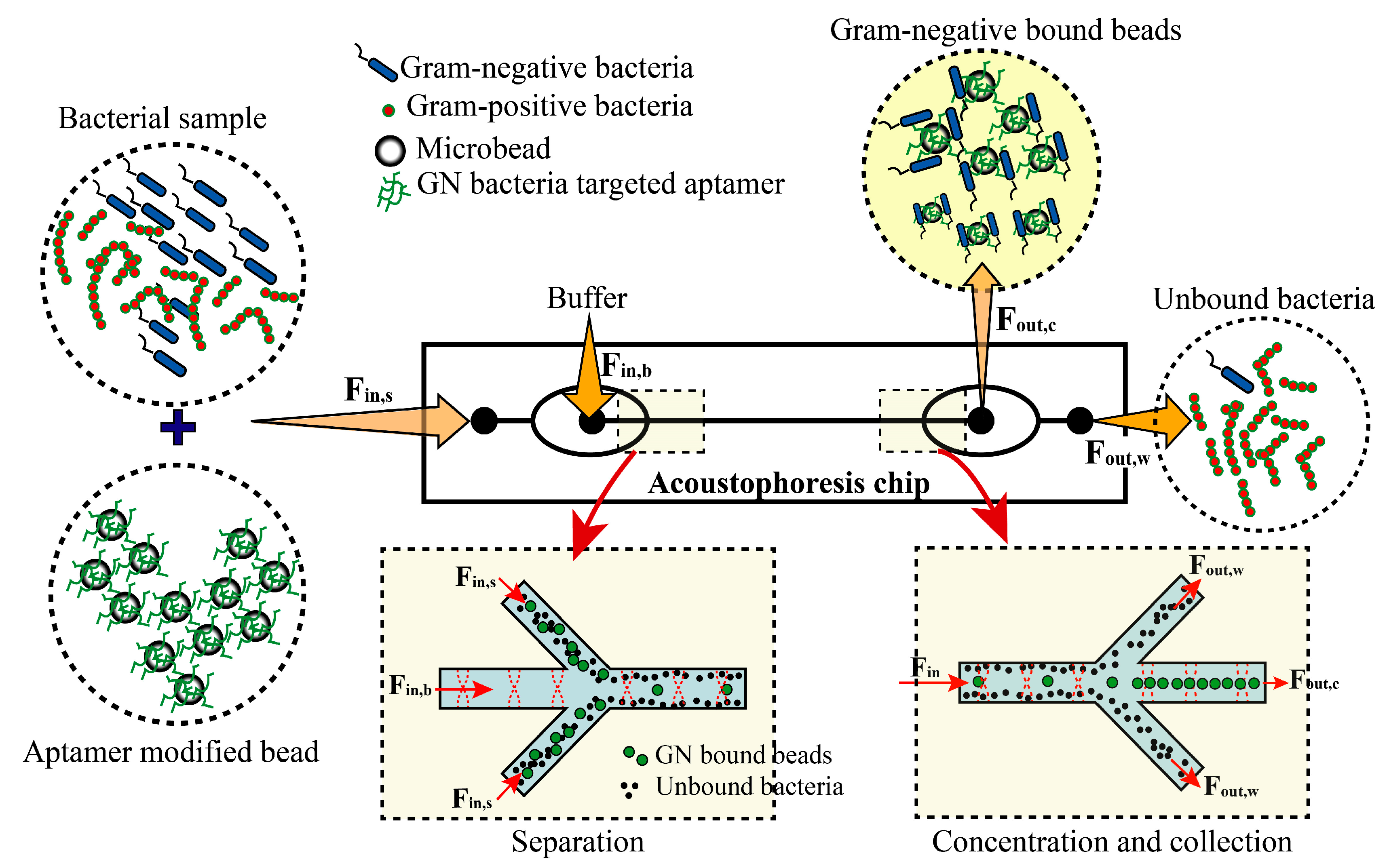
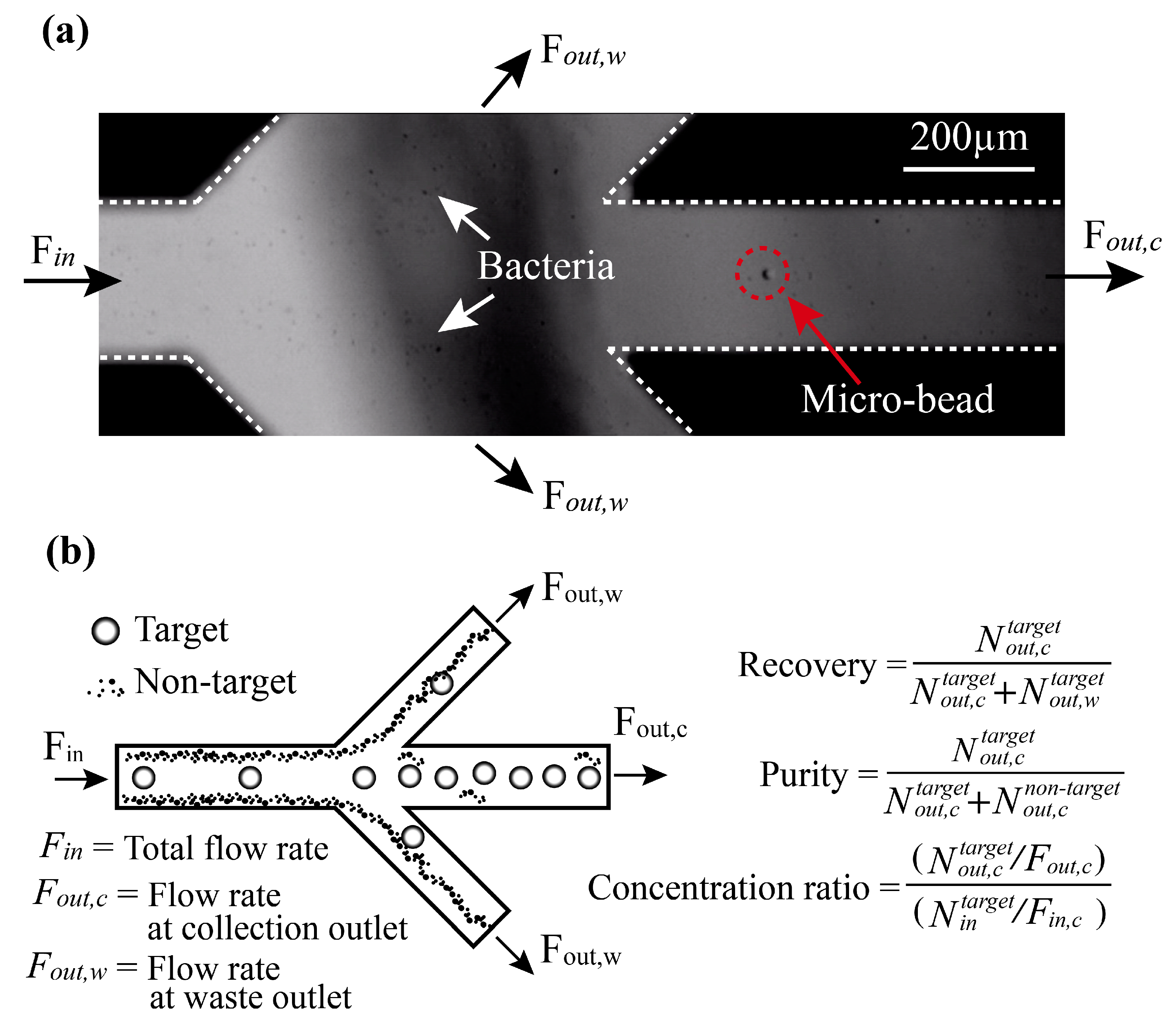
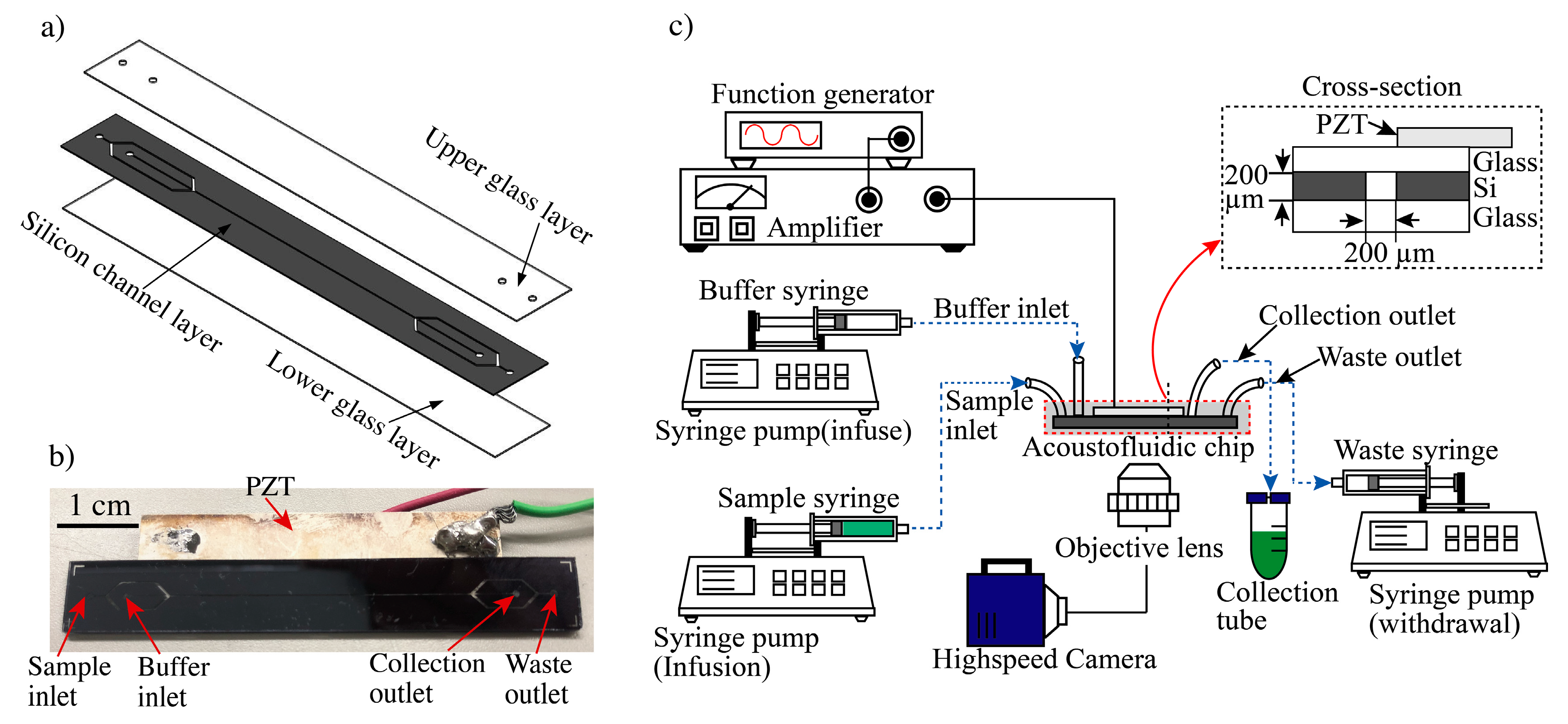
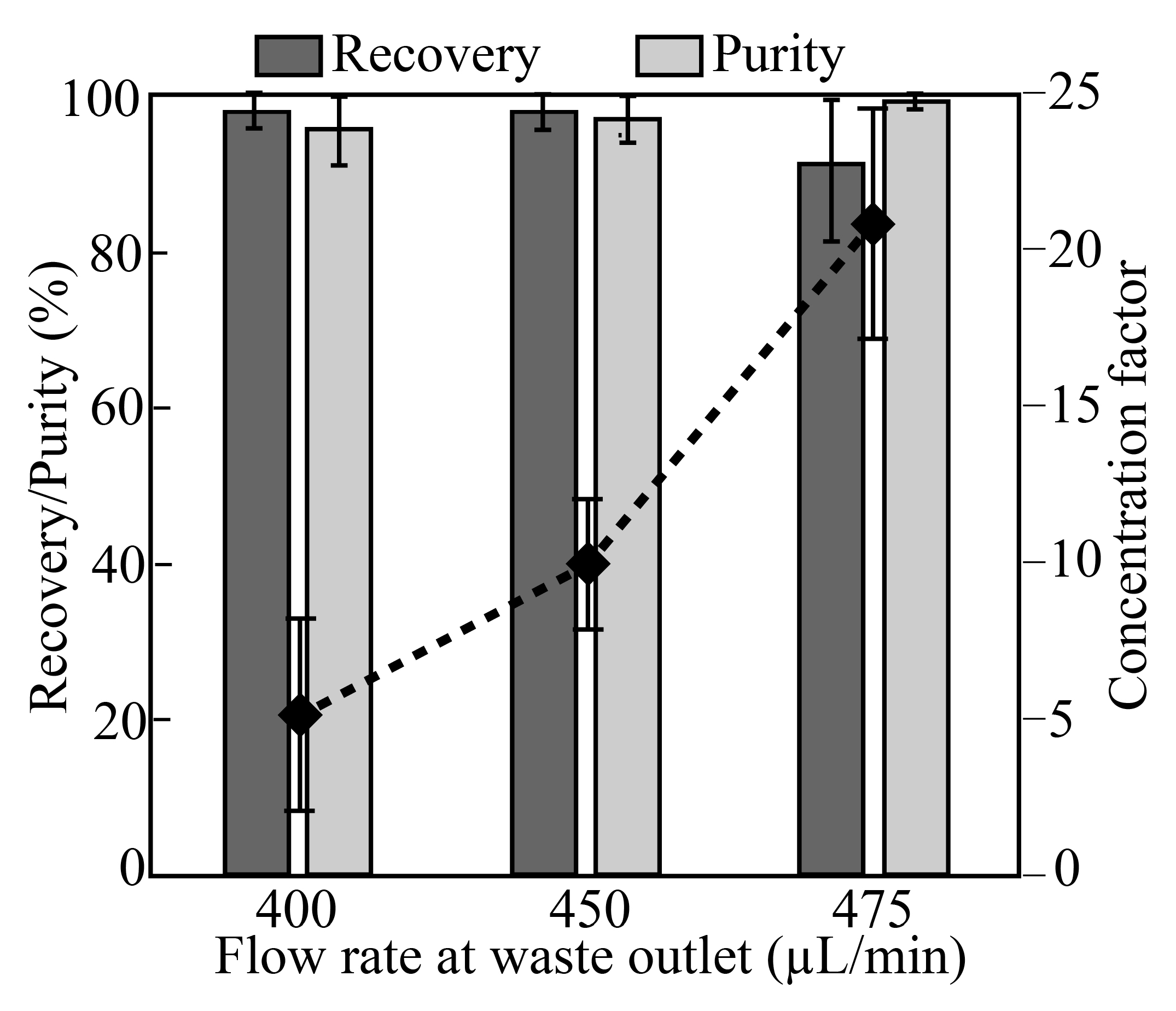
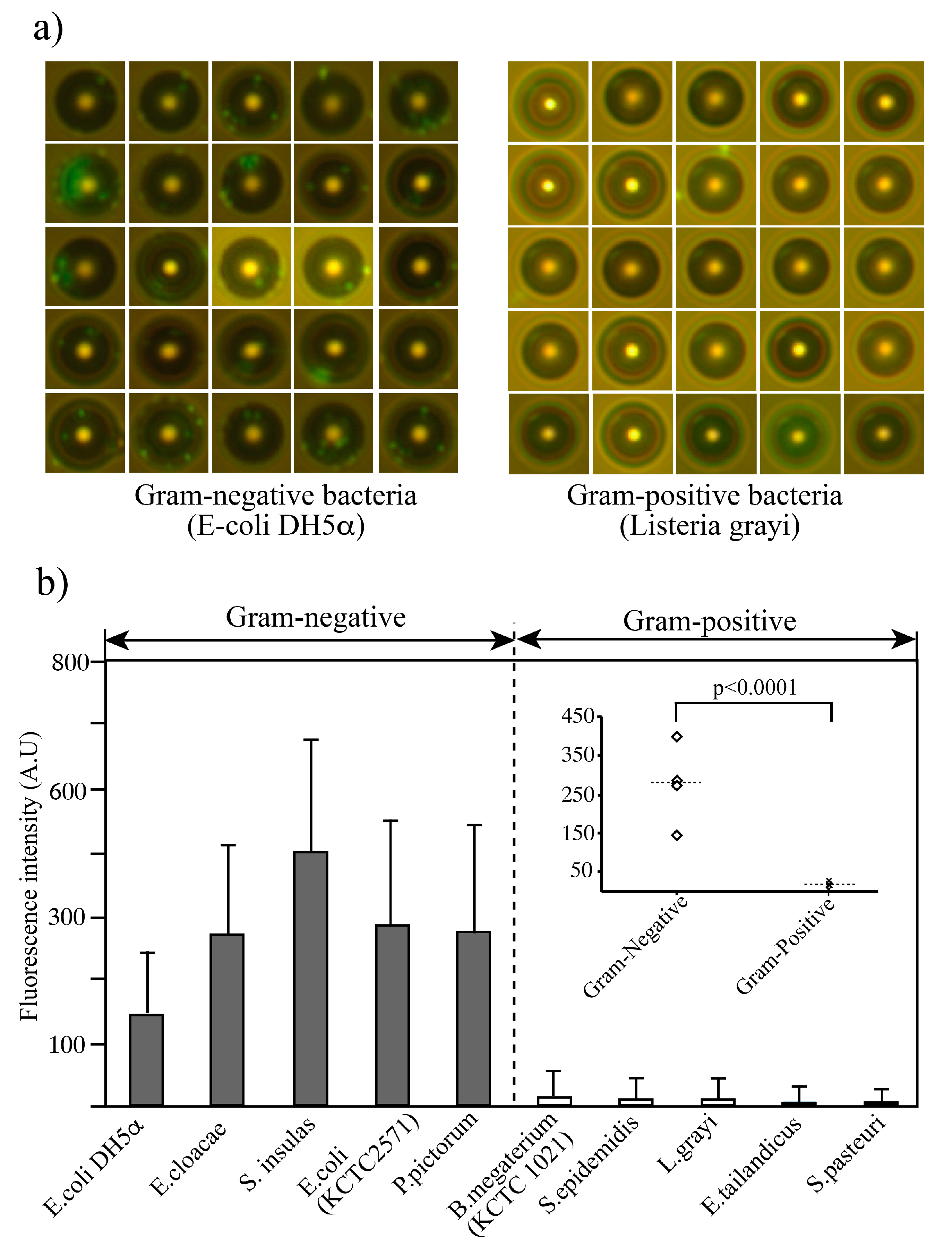
| Gram-Negative Bacteria | Gram-Positive Bacteria |
|---|---|
| Escherichia coli DH5α | Bacillus megaterium (KCTC 1021) |
| Enterobacter cloacae | Staphylococcus epidermidis |
| Sphingomonas insulae | Listeria grayi |
| Escherichia coli KCTC 2571 | Enterococcus thailandicus |
| Pseudomonas pictorum | Staphylococcus pasteuri |
| Bead-Labeling | Microfluidic Method | Affinity Legend | Sample Throughput | Purity | Target Cell Recovery | Reference |
|---|---|---|---|---|---|---|
| Label-free | Inertia | N.A | 8 mL/min | 99.87% | 62% | [32] |
| Membrane filter | N.A | 500 µL/min | – | 89.9% | [33] | |
| SSAW | N.A | 1 µL/min | 95.65% | N.A. | [34] | |
| BAW (Impedance matches) | N.A | 400 µL/min | 90% | 99% | [35] | |
| DEP | N.A | 0.5 µL/min | – | 87.2% | [36] | |
| Affinity bead | DEP & Magnetophoresis | Antibody | 8.3 µL/min | 95% | 98% | [37] |
| Magnetophoresis | Antibody | 150 µL/min | 80% | – | [38] | |
| BAW (This work) | Aptamer | 500 µL/min | 99.5% | 98% (Bead recovery) |
© 2019 by the authors. Licensee MDPI, Basel, Switzerland. This article is an open access article distributed under the terms and conditions of the Creative Commons Attribution (CC BY) license (http://creativecommons.org/licenses/by/4.0/).
Share and Cite
Lee, S.; Kim, B.W.; Shin, H.-S.; Go, A.; Lee, M.-H.; Lee, D.-K.; Kim, S.; Jeong, O.C. Aptamer Affinity-Bead Mediated Capture and Displacement of Gram-Negative Bacteria Using Acoustophoresis. Micromachines 2019, 10, 770. https://doi.org/10.3390/mi10110770
Lee S, Kim BW, Shin H-S, Go A, Lee M-H, Lee D-K, Kim S, Jeong OC. Aptamer Affinity-Bead Mediated Capture and Displacement of Gram-Negative Bacteria Using Acoustophoresis. Micromachines. 2019; 10(11):770. https://doi.org/10.3390/mi10110770
Chicago/Turabian StyleLee, SangWook, Byung Woo Kim, Hye-Su Shin, Anna Go, Min-Ho Lee, Dong-Ki Lee, Soyoun Kim, and Ok Chan Jeong. 2019. "Aptamer Affinity-Bead Mediated Capture and Displacement of Gram-Negative Bacteria Using Acoustophoresis" Micromachines 10, no. 11: 770. https://doi.org/10.3390/mi10110770
APA StyleLee, S., Kim, B. W., Shin, H.-S., Go, A., Lee, M.-H., Lee, D.-K., Kim, S., & Jeong, O. C. (2019). Aptamer Affinity-Bead Mediated Capture and Displacement of Gram-Negative Bacteria Using Acoustophoresis. Micromachines, 10(11), 770. https://doi.org/10.3390/mi10110770





